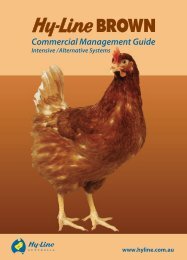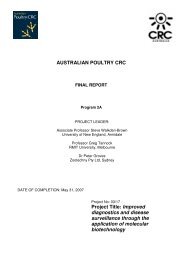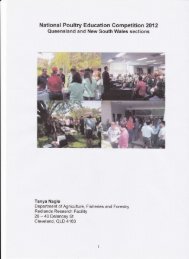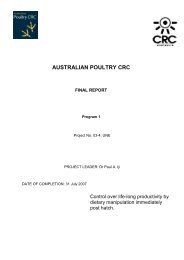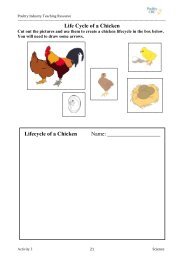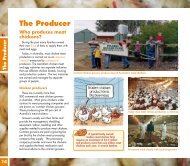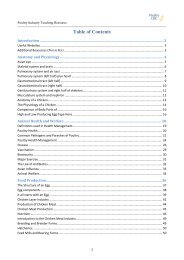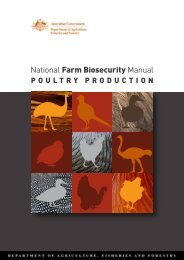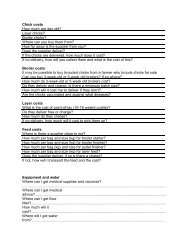AUSTRALIAN POULTRY CRC - Poultry Hub
AUSTRALIAN POULTRY CRC - Poultry Hub
AUSTRALIAN POULTRY CRC - Poultry Hub
- No tags were found...
You also want an ePaper? Increase the reach of your titles
YUMPU automatically turns print PDFs into web optimized ePapers that Google loves.
Producers were asked, if known, what were the main causes of mortality in their birds (includingdeaths and culls) and at what age did they occur. They were asked to rank in order of importance from1 (most often the cause of mortality) to 10 (least often the cause of mortality) (Table 7).Table 7: Causes of mortality and rank of importance with 1, most often the cause of mortality, to 10least often the cause of mortality.LocationQLD NSW VIC SACause Rank Age(wks) Rank Age(wks) Rank Age(wks) Rank Age(wks)Fowl cholera 1,1 >18Marek‟s disease 8 15 9 10Salmonella sp. 10Coccidiosis 7 Summer 8Chronic respiratorydisease7Spotty liver 2 Summer 1 All 8 30-40Worms 6 15-20 6Egg peritonitis 2,2 3,5 >38Prolapse/protrusion 3 30-40 4,6,8 1,9 >24Cannibalism 2,2,8 >18 4 30-40 1,4,7Vent pecking 3,9 1 30-40 2,3,5 2 >24Physical injury 8 5 15 5,7Predators 1,2,8 9 1,1,3,6 AllHeat Stress 10 Summer 2,2,2,4 OldThe owner/manager of the free range farm most often determined the cause of mortality (80 – 100% ofthe time) with veterinarians and pathology labs determining cause of death 1 – 20% of the time.DiscussionThe objective of the nationwide survey of free range layer producers in Australia was to indicatecauses of mortality in the industry to tailor the epidemiological survey to ensure temporal/localityissues were covered. Of the fourteen free range producers who replied to the survey the results showthat housing conditions, hens and management did not show any particular trend when looking atindividual states.Fowl cholera was named as the most important cause of mortality in Queensland however was notconsidered a problem at all in the other states. Fowl cholera is mainly transmitted from bird to bird bywater and feed contamination with rodents also playing a role in contamination. All farms recordedthat they undertook regular rodent baiting. It is also found in puddles of water and dams in the rangearea and four of the five farms in Queensland reported that there are water courses/dams on theirHowever all other states also recorded farms with water courses/dams and did not report choleraproblems. Stress conditions (overcrowding, cold weather, unhygienic sheds and poor ventilation) canalso trigger infection outbreaks. Cold weather is unlikely to be a problem in Queensland and all butone farm reported undertaking rigorous cleaning of sheds between flocks. Three of the fiveQueensland respondents vaccinated their flocks against fowl cholera however as this vaccine containsthe three most common serovars in Australian poultry cross protection to any of the other 13 serovarsis likely to be limited.New South Wales and Victoria recorded spotty liver as one of their most important causes of mortalitywith South Australia giving it a low rank and Queensland producers not considering it a problem at all.Spotty liver generally occurs in flocks kept on the ground either in a shed (barn) or where they birdsare free to range. Liver lesions look a lot like that produced by Pasteurella multocida (fowl cholera)and flocks respond well to antibiotic treatment however they often relapse (Critchley, 2002).14



